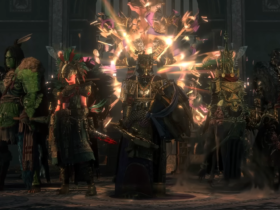What are the best Delta Force settings? To ensure you and your compatriots are primed and ready to fight for your lives on the epic battlefront of Delta Force, we’ve tried and tested the game settings to find the best way to maximize your FPS and get the best experience overall.
As a taut, team-based, tactical first-person shooter, Delta Force is all about balancing enough detail to keep a keen eye on the battlefield, while also maximizing your fps for a smooth feel and accurate aiming. All that means you’ll be wanting a decent GPU to get anywhere with the game. However, the Delta Force system requirements aren’t as demanding as you might imagine, so you don’t absolutely have to have the very latest and best graphics card in your system to still have a great time.

Best Delta Force graphics settings
Basic Graphics
- Graphics Preset: Custom
- Graphics Style: Default
- Weapon Motion Blur: Off
- Reflections: High
- Texture Filtering: High
- Ambient Occlusion: High
- Particles: High
- Distortion: High
- Scene Details: High
- Scene View Details: High
Advanced Graphics
- Rendering Scale: 100
- Depth of Field: Off
- Global Illumination Quality: High
- Shaders: High
- Textures: High
- Streaming: High
- Shadows: High
- Shadow Map: High
- Post-Processing: High
- Volumetric Fog: High
- Animation: High
Super Resolution
- Super Resolution Mode: Off
- Super Resolution: Off
- Nvidia Reflex: On (if you have a Nvidia graphics card)
Display
- Monitor: Your preferred gaming monitor
- Display Adapter: Auto
- Display Mode: Fullscreen
- Display Refresh Rate: Your monitor’s maximum refresh rate.
- Show Aspect Ratio: Auto
- Brightness: 50
- Frame Rate Cap: Unlimited
- Sharpness: 50
- V-Sync: Off
Field of View
- Default FOV: 120
- Scope Magnification: On
While Delta Force Black Hawk Down is more of a single-player focused experience, Delta Force is, at its heart, a competitive multiplayer first-person shooter. As such, while the game looks good if you turn on all the graphical details, getting a solid frame rate of well above 60fps – ideally over 120fps – should be your priority.
Thankfully, for our RTX 4070-equipped test system, that was achievable with the game’s graphics detail settings mostly maxed out, when running the game at 1080p. We recorded an average frame rate of 134fps with a decent 74fps 1% low frame rate, netting us a consistently smooth-feeling experience.
However, in an ideal world, we’d want to run the game at a slightly higher resolution. That’s because the long draw distances and precision required to get the most from this game really benefit from a few extra pixels. It’s very much like CoD Warzone in this way.

Thankfully, after turning up the resolution to 1440p, we still achieved an average frame rate of 118fps, which is close enough to our target frame rate. The 1% low didn’t drop at all either, suggesting the occasional dips in frame rate are more CPU-dependent than a strain on your graphics card.
When we cranked the resolution up to 4K, though, the game took a big hit to performance. It registered just a 71fps average with a 47fps 1% low, and the game felt noticeably difficult to play because of it. It’s at this point you might want to consider turning on DLSS upscaling or frame generation. However, we’d recommend opting instead to sticking to running at 1440p instead of running at 4K with upscaling or frame generation. That’s because these technologies can introduce visual oddities and slight lag to the game, which can affect your aim.
Meanwhile, if you’re struggling to hit the frame rates we’re getting, we recommend turning down most of the in-game detail settings before opting to try upscaling or frame generation in this title.
There are a few settings we’d also just always recommend leaving turned off in a competitive shooter such as this one, mainly motion blur and depth of field effects. These effects can look cinematic for single-player first-person shooters but can get in the way when you’re competing. You should always keep V-Sync turned off too, to avoid stutter, though do use AMD Freesync or Nvidia G-Sync if they’re available to you.
How we test Delta Force
At PCGamesN, we use dedicated gaming rigs to test the best settings for performance and gameplay in the latest releases. The test rig used for Stalker 2 includes the following components: Intel Core i7 11700F, Nvidia GeForce RTX 4070 12GB, 32GB of DDR4 3,200MHz RAM, MSI B560 motherboard. We also test using Windows 11 64-bit.
We always run our testing first at 1,920 x 1,080 to identify the best settings at the most commonly played resolution, then again at 2,560 x 1,440 and even 4K using the same setup to gauge the difference in performance. We use CapFrameX to capture frame data and compare testing sessions.
How to monitor performance in Delta Force
If you want to keep an eye on performance in Delta Force, you can follow these instructions to find an easy method that works whether you’re using an Nvidia or AMD graphics card.
For Nvidia cards, ensure you have GeForce Experience or the Nvidia App installed and the in-game overlay enabled. Then hit Alt + R in-game to bring up your performance monitor. With AMD cards, you can enable performance monitoring via the Radeon overlay using the shortcut Ctrl + Shift + O.
Alternatively, you can download free software such as CapFrameX or Nvidia FrameView to get a cleaner, more simplified benchmarking tool that works with any graphics card.
If you need to upgrade your hardware to start playing Delta Force, follow our handy guide on how to build a gaming PC, which takes you through the process step by step from start to finish.
And that concludes our best Delta Force settings guide. If you’re looking to find out more about the game, check out our Delta Force weapons and Delta Force operators guides, which each explain these crucial features of the game.












Leave a Reply